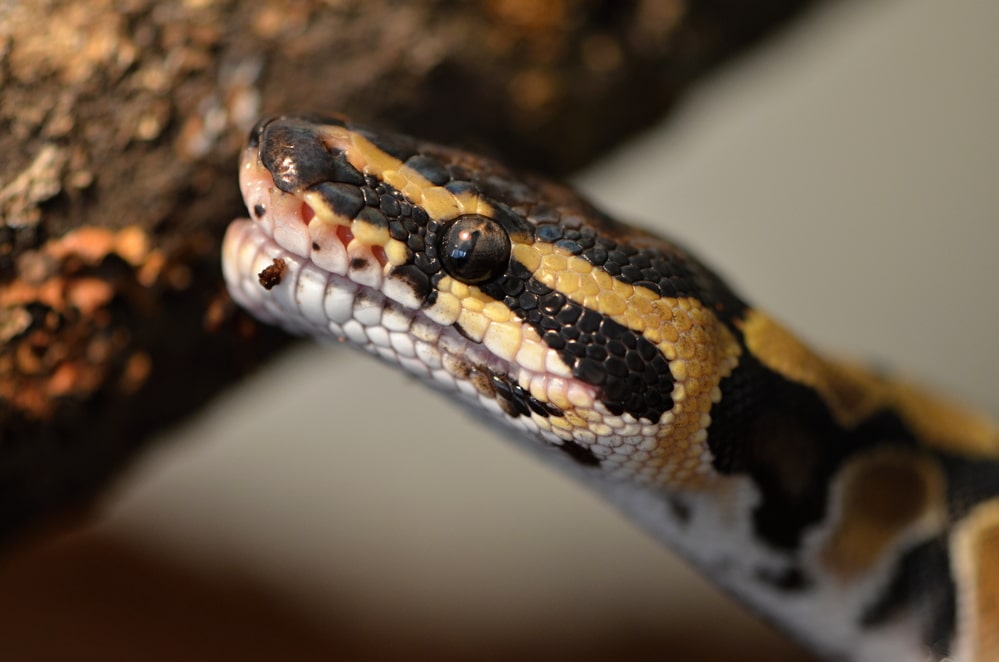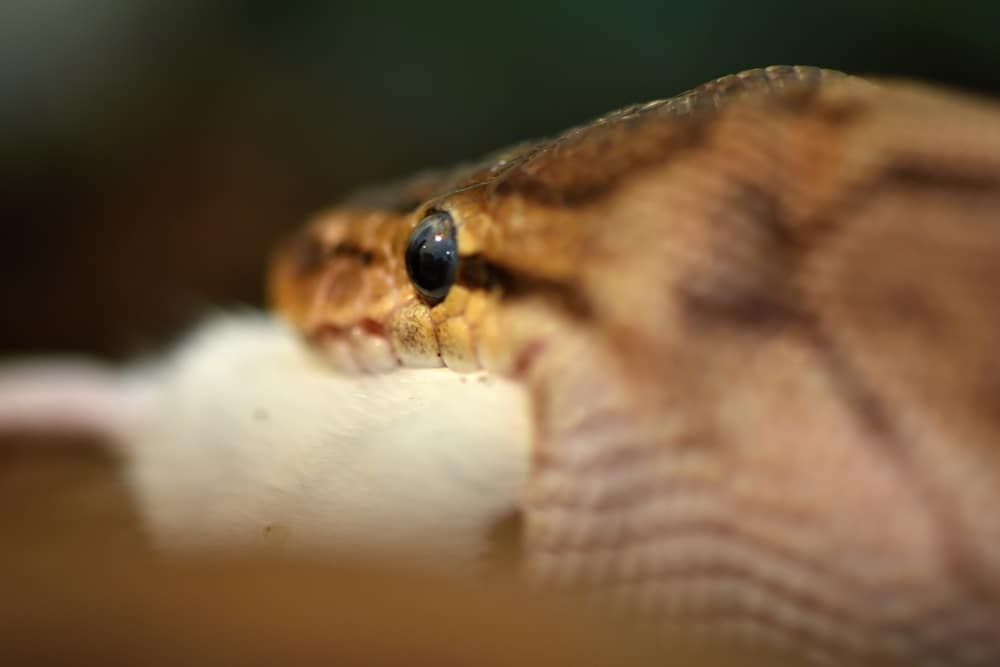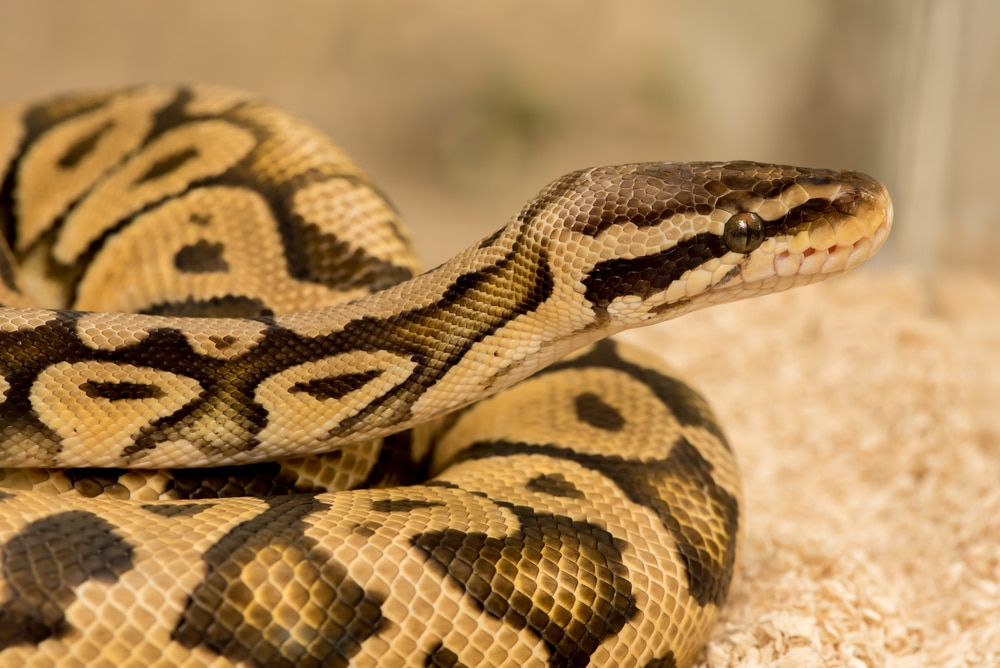Feeding is one of the most interesting aspects of snake care. Many keepers enjoy this aspect of snake husbandry, but others – particularly beginners – often feel intimidated by the entire process.
We’re here to explain everything you need to know about feeding your ball python.

This includes subjects ranging from prey selection to presentation style, and we’ll also provide a few tips for getting stubborn ball pythons to eat.
Quick Navigation
The Basics of the Ball Python Feeding Process
In case this is your first ball python, or you’ve never fed a snake before, we’ll begin by outlining the basic feeding process:
- You’ll begin by selecting an appropriately sized prey item.
- You’ll then grip the prey item with a pair of long tongs. (This assumes you are using a frozen-thawed rodent. We’ll discuss the procedure for feeding a live rodent later, but most keepers should try to use frozen-thawed rodents whenever possible.)
- If necessary, you’ll gently warm the prey item.
- You’ll then move the prey item in front of your snake’s face.
- If your snake doesn’t immediately strike the prey item, you may need to move it around slightly.
- Once the snake strikes the food item, release your grip with the tongs.
- Slowly back away and close the enclosure.
- Observe or monitor your snake to ensure he completes the feeding process from afar.
- Wash your hands.
That’s all there is to it, but we’ll cover several aspects of the process in greater detail below.
Prey-Selection for Ball Pythons

The first step in feeding your ball python is to select the proper prey item.
This essentially involves making three decisions: You must decide what species to feed your pet, you must determine the proper prey size to offer your snake, and you must decide whether you want to feed your pet live or frozen-thawed prey.
We’ll examine each issue individually below.
Ball Python Prey Selection: Prey Species
In the wild, ball pythons primarily subsist on rodents, but they may also consume birds or lizards on occasion.
In captivity, commercially reared feeder rodents are the best choice, but you’ll still need to decide whether rats or mice make more sense.
Ultimately, it doesn’t matter very much while your snake is young, and you can simply choose the option that is easier for you to acquire or appears more appealing to your pet.
However, you’ll likely want to switch to rats once your snake reaches maturity (if not before), as it may take several mice to satiate a large ball python.
There are a number of other prey species available to snake keepers, including hatchling chicks and ducks, as well as gerbils, hamsters and other common rodent pets. But it is wise for keepers to stick to mice and rats, as they’re generally more affordable and easier to acquire.
The only exception to this recommendation is when you are faced with a ball python who repeatedly and stubbornly refuses to accept mice or rats.
In such cases, you may need to experiment with other species (with gerbils typically being the most likely to tempt your pet).
Ball Python Prey Selection: Prey Size
The second decision you must make relates to the size of the prey item you select. As long as your snake will accept the prey item, there isn’t a danger in erring on the small side.
But, doing so over time may fail to provide your pet with enough food, unless you feed multiple prey items at each feeding or adopt a frequent feeding schedule.
However, you must avoid selecting a prey item that is too large.
Doing so may simply cause your snake to refuse to eat, but if your snake does manage to choke down something that is too large, he may later vomit it back up.
In rare circumstances, it may even cause injuries to his digestive tract.
As a rule of thumb, you’ll want any prey item you offer to be about 1 to 1.25 times the size of your snake at mid-body (although advanced keepers may be comfortable feeding rodents approaching 1.5 times the snake’s mid-body diameter).
The prey item should create a moderate, yet distinct bulge in your snake, which will slowly shrink over the course of a few days.
Don’t place too much emphasis on the labels retailers place on their rodents, such as “small,” “medium” or “large.”
These labels vary wildly and rarely prove helpful. However, once you determine the correct size for your pet, you may be able to refer to the bodyweight of the prey when ordering new rodents in the future.
Ball Python Prey Selection: Live or Frozen-Thawed?
In the wild, snakes typically catch, subdue and consume live prey items. But this isn’t necessary for most captive snakes (especially captive-bred individuals).
Captive snakes will generally accept or learn to accept frozen-thawed rodents instead.
You’ll ultimately have to decide which type of prey to offer your pet, but frozen-thawed rodents are typically the better choice for a variety of reasons, including:
- Frozen-thawed rodents will not suffer the trauma of being hunted, bitten and constricted.
- Frozen-thawed rodents are not capable of injuring your pet by biting him.
- Frozen-thawed rodents are probably less likely to transmit parasites to your pet.
- Frozen-thawed rodents are easier to store and handle.
Some ball pythons may refuse frozen-thawed rodents, but you should usually attempt to transition them over time.
If you do have to feed your snake live prey, be sure to monitor your pet closely and be ready to intervene if the rodent begins biting your snake.
Preparing Your Snake’s Food
Now that you have a suitable prey item of the proper size, you must prepare it before offering it to your snake. Fortunately, there’s not very much you’ll need to do.
If you are using a live rodent, you simply need to ensure that it has recently eaten (to help prevent it from viewing your snake as potential food) and that it is clean.
This means ensuring that it does not have any bedding or feces stuck to its fur. Remember to treat the prey animal with compassion and respect at all times.
If you intend to feed your snake a frozen rodent, you’ll need to begin by thawing it out. The best way to do so is by simply setting the rodent out on a few paper towels or newspaper sheets in a warm room.
Wait to offer the rodent to your snake until it is completely thawed and no longer rigid.
Do not use the microwave to thaw it (doing so will not only contaminate your microwave with germs, it may lead to a horrifying mess if you accidentally microwave it for too long).
If you must accelerate the thawing process, simply place the rodent in a container of lukewarm water.
It may be helpful to gently warm the thawed rodent’s head to make it appear more natural to your snake (remember, ball pythons have thermoreceptive pits near their mouths, which help them to identify, track and capture warm-blooded prey).
One of the best ways to do so is by briefly and gently touching the rodent’s head to a heat lamp bulb. Just be careful not to overheat it – you want the rodent warm, not hot.
Presenting Your Snake with Food
If you are feeding your snake a live rodent, you can simply open the enclosure and gently put the rat or mouse inside.
Be careful that you don’t move your hand in front of your snake at this time, as he may make a mistake and strike your hand rather than his prey.
Monitor the snake and rodent carefully, until your snake has captured, constricted and begun to consume it.
On the other hand, if you intend to feed a frozen-thawed rodent to your snake, you’ll need to start by gripping the rodent with a pair of long feeding tongs. Grip the back half of the rodent, so that you can present the rodent’s head directly to your snake.

Be sure that your snake has plenty of room to bite the rodent, without its teeth contacting the tongs.
At this point, you’ll want to open the enclosure and slowly bring the rodent in front of your snake’s face.
Hopefully, this is all the encouragement he’ll need, and he’ll quickly strike and constrict the rodent.
However, if he does not do so, you may need to “animate” the rodent a bit by wiggling it around. This will help make it appear alive, which is necessary for some ball pythons. Be careful not to move it too aggressively, as this may intimidate some ball pythons.
Once the snake bites and constricts the prey, release your grip on the rodent. Slowly back away from the habitat to avoid spooking your snake and close the enclosure door.
Continue to monitor the situation to ensure your snake eats, but because the rodent is not alive, you needn’t monitor them constantly.
Feeding Safety
Ball pythons don’t reach sizes that make them a serious threat to your safety, but you’ll still want to use care to avoid being bitten during the feeding process.
The use of feeding tongs and common sense will help you do so in most cases but be sure that you avoid inadvertently putting your hands (or face) within striking distance while your snake smells food.
It is also important to keep your snake’s safety in mind.
Feeding your pet frozen-thawed rodents will eliminate most of the risks the rodent poses, but you’ll want to be careful to keep the tong tips far enough back that your snake doesn’t accidentally strike them with his teeth.
Finally, you’ll want to be sure that you provide a suitably warm basking spot for your snake while he’s digesting.
If you fail to do so, the rodent may decompose faster than his body can digest it, which will typically lead to him vomiting it back up. This usually isn’t a serious problem, but it will mean that your snake may become susceptible to short-term dehydration.
It will also mean that you’ll want to allow the snake’s digestive tract to rest for at least a week before offering food again.
Feeding Frequency: How Often Should You Feed Your Ball Python?
One of the most common questions new keepers have relates to the frequency with which they should feed their snake.
The answer will vary based on a variety of factors, but we’ll try to outline some of the most common feeding regimens below.
- In most cases, a once-per-week feeding schedule is appropriate. This is the standard advice provided to most fledgling keepers and it works well for the snake as well as the snake keeper. This way, you can just decide that a particular day of the week will be feeding day and adjust your husbandry practices accordingly.
- If you are trying to promote rapid growth, you can feed a young ball python once every three or four days. Such an aggressive feeding schedule should not be employed haphazardly, but if your pet is healthy and you’re providing ideal habitat parameters, most young ball pythons will eat and digest food at this pace.
- Mature adult ball pythons will often thrive and maintain good body weight when fed once every two to three weeks. Obesity can cause problems for snakes, so you must be careful to avoid feeding your snake too much. Because mature adults do not use many of their calories for growth, they can easily become overweight if fed large prey items on a once-per-week schedule.
Understand that these are simply guidelines – you must monitor your snake’s body weight and growth rate, and then make adjustments as necessary. Also, remember that the size of the prey items you offer will influence the frequency with which you should offer them.
If you provide very large meals to your snake, you’ll want to feed him less frequently than a similar keeper, who prefers to feed smaller prey items.
Tempting Reluctant Eaters to Feed
Ball pythons – like many other snake species – may occasionally refuse the food items their keepers offer.
This isn’t as big a problem for modern keepers as it was for ball python enthusiasts in decades past, as most ball pythons on the market are now captive-bred, rather than wild-caught.
Nevertheless, keepers may occasionally find that their snake is disinterested in the food items offered.
Accordingly, we’ve tried to share a few helpful tips and tricks below, which may help tempt your pet to resume feeding.
- Don’t panic if your snake refuses to eat. Snakes take an incredibly long time to starve – on the order of months for otherwise healthy individuals. So, try to avoid panicking if your snake refuses food and simply try again a few days later.
- Ensure that your husbandry practices are good, and that the habitat is set up ideally. Poor husbandry or habitat-design errors are some of the most common causes of food refusal. Double-check the habitat temperatures and humidity level and be sure that you are providing at least one snug hiding space anytime your snake refuses prey.
- Try feeding your snake at night, in low-light conditions. Ball pythons are typically nocturnal in the wild and switching to a nighttime feeding schedule will often yield better results.
- Experiment with rodents of different colors. Snakes aren’t thought to be capable of seeing color, but they can still distinguish between light-colored and dark-colored rodents. Most wild rodents are dark, unlike domestic rodents, which are often white. So, try to find some grey, brown, black or multi-colored rodents for your snake’s next meal.
- Place your snake in a small container with a frozen-thawed rodent. Sometimes, simply placing your snake in a confined space with a frozen-thawed rodent (never use live rodents in this manner) will entice him to feed. You may need to leave the snake in the container overnight, but this trick is often surprisingly effective.
- Consider using scent-transfer techniques. Scent-transfer techniques involve making an easy-to-acquire food source (such as a mouse) smell like a more natural, harder-to-source species (such as a lizard or bird). Scent-transfer techniques aren’t as effective for ball pythons as they are for some other species, but they’re still worth trying. So, if your snake refuses food, consider rubbing a bird or lizard on the rodent before offering it to your snake.
- Experiment with different prey species. If nothing else proves effective, you may want to try to offer your snake a different prey species. It may be helpful to try other rodents, such as gerbils or hamsters, but you could also try lizards or birds.
- Try live prey, rather than frozen-thawed prey. As a last resort, you may want to try to offer your snake a live rodent. This is often effective, but you must be sure to monitor your pet closely and intervene if the rodent begins trying to injure your pet.
If you are unable to get your snake to resume feeding after trying the recommendations listed above, or your snake’s fast lasts longer than three or four weeks, it is a good idea to take your snake to the vet for an evaluation.
Infections, parasites and other health problems may be causing your snake to refuse food. Fortunately, most of these issues can be corrected with competent veterinary care.
Conclusion
Beginning snake enthusiasts must cope with a steep learning curve as it relates to feeding your ball python, but you’ll become more comfortable with the process over time.
Just be sure to follow the tips and suggestions above and learn as much as you can from keepers with more experience than you.